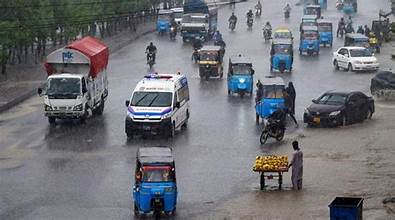Karachi, Pakistan’s bustling metropolitan hub, is once again in the spotlight as the Pakistan Meteorological Department (PMD) has predicted rainfall in the city starting from August 30. Known for its unpredictable weather patterns, Karachi often experiences sudden showers that not only bring relief from scorching heat but also pose challenges for its infrastructure, traffic system, and urban planning. The latest forecast has raised both anticipation and concerns among residents, businesses, and government authorities.
PMD’s Forecast and Predictions
The PMD issued its advisory stating that moist currents from the Arabian Sea are likely to penetrate southern parts of Sindh, including Karachi, leading to the development of rain-bearing clouds. The weather experts have indicated that light to moderate showers are expected in various areas of the city, while heavy downpours in some localities cannot be ruled out.
According to PMD’s data, this rainfall is part of the broader monsoon system that has already affected parts of Punjab, Khyber Pakhtunkhwa, and Balochistan. Karachi, being a coastal city, often receives delayed but intense monsoon activity, and the end of August has historically been a period when rains strike the region with varying intensity.
Relief from Scorching Heat
Karachiites have endured extremely hot and humid conditions throughout August, with the mercury frequently crossing 35°C coupled with high humidity levels. The prediction of rain has brought a sigh of relief, especially for those who struggle without uninterrupted power supply and cooling systems. For many residents, rainfall in Karachi is not just a weather event—it is a source of emotional joy, nostalgia, and relief after long spells of heat. Children and families often welcome the rains as a time to enjoy street food, long drives along Seaview, and the pleasant sea breeze that follows.
Challenges for Karachi’s Infrastructure
While rainfall is a natural blessing, it also exposes the vulnerabilities of Karachi’s urban infrastructure. The city’s outdated drainage system, encroachments on stormwater drains, and lack of timely municipal management often turn a refreshing downpour into urban flooding. In past years, even moderate showers have led to severe waterlogging in areas like Saddar, Clifton, North Nazimabad, Gulshan-e-Iqbal, and Korangi.
The accumulation of rainwater disrupts daily life, damages property, and hampers economic activities. Roads submerged under knee-deep water not only delay transportation but also contribute to the rapid deterioration of the already fragile road network. Furthermore, prolonged waterlogging often becomes a breeding ground for mosquitoes, increasing the risk of diseases like dengue and malaria.
K-Electric and Power Outages
Another major concern for Karachi residents during rains is the recurring issue of power breakdowns. K-Electric, the city’s sole electricity provider, often faces criticism during the rainy season as large parts of the city plunge into darkness after even light showers. Fallen power poles, short circuits, and tripping feeders are common during rain spells. The company has assured that it has taken precautionary measures this time, but many citizens remain skeptical given the history of extended outages.
Government and Municipal Preparations
In light of PMD’s forecast, local authorities have reportedly taken steps to prepare for the upcoming rain spell. The Karachi Metropolitan Corporation (KMC) and Sindh government have instructed their teams to clean major stormwater drains (nullahs) and ensure the deployment of emergency response units in flood-prone areas.
Rescue services and municipal bodies are also expected to remain on high alert, with pumps and machinery placed in key areas to remove water accumulation. However, whether these measures will prove sufficient remains to be seen, as the scale and intensity of rain can often overwhelm available resources.

Citizens’ Perspective and Precautions
For ordinary citizens, rain in Karachi brings mixed feelings. On one hand, there is excitement and relief from the oppressive heat, but on the other, there is anxiety about flooded roads, long traffic jams, and potential property damage. Many families take precautionary measures such as:
- Stocking up on groceries in advance.
- Ensuring backup power solutions like UPS or generators.
- Avoiding unnecessary travel during heavy showers.
- Securing rooftops and open areas to prevent leaks or water damage.
Citizens are also advised to avoid areas near electrical poles and wires during rainfall, as electrocution incidents have been tragically common in the past.
Environmental and Economic Impact
Rainfall also has significant environmental and economic effects in Karachi. On the positive side, it helps reduce dust pollution, cools down the city’s climate, and replenishes underground water tables. For street vendors and food businesses, rain often brings increased demand, as residents flock to enjoy traditional snacks like pakoras, samosas, and chai.
On the flip side, heavy rains disrupt transportation of goods, halt industrial activities in low-lying areas, and cause financial losses to small businesses. Shopkeepers often suffer when water seeps into their shops, damaging merchandise. For daily wage earners, rainfall can mean lost income due to work interruptions.
Historical Context of Karachi Rains
Karachi has a history of receiving unpredictable rainfall, with some years experiencing record-breaking downpours. The devastating monsoon of 2020 is still fresh in people’s minds, when prolonged heavy rains resulted in widespread flooding, loss of lives, and massive damage to infrastructure. That year, the city recorded more than 230 mm of rain in a single day, the highest in nearly a century.
Given this backdrop, every forecast of rainfall is taken seriously by residents, who remain wary of a repeat of such situations. This is why even the prospect of light to moderate rain leads to urgent preparations by both authorities and citizens.

Looking Ahead
As Karachi braces for rain from August 30, the city stands at a crossroads between hope and caution. On one hand, the showers are expected to bring relief from the oppressive heat, clean the air, and add a refreshing touch to daily life. On the other, the looming threat of urban flooding, power outages, and infrastructural breakdowns cannot be ignored.
The situation highlights the urgent need for long-term urban planning, investment in modern drainage systems, and efficient disaster management strategies. While Karachi may be able to withstand this upcoming spell, the city requires robust solutions to ensure that rain remains a blessing rather than a calamity.



